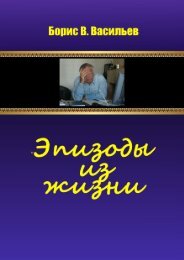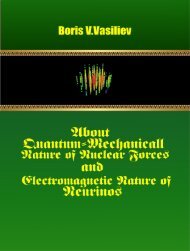978-1-940366-36-4_WholeBook
Boris V. Vasiliev Supercondustivity Superfluidity
Boris V. Vasiliev
Supercondustivity Superfluidity
Create successful ePaper yourself
Turn your PDF publications into a flip-book with our unique Google optimized e-Paper software.
Superconductivity and Superfluidity<br />
It is believed that the BCS-theory [13] has the following main results:<br />
1. The attraction in the electron system arises due to the electron-phonon interaction.<br />
As result of this attraction, the ground state of the electron system is separated from<br />
the excited electrons by an energetic gap. The existence of energetic gap explains<br />
the behavior of the specific heat of superconductors, optical experiments and so on.<br />
2. The depth of penetration (as well as the coherence length) appears to be a natural<br />
consequence of the ground state of the BCS-theory. The London equations and the<br />
Meissner diamagnetism are obtained naturally.<br />
3. The criterion for the existence of superconductivity and the critical temperature of<br />
the transition involves itself the density of electronic states at the Fermi level D(E F )<br />
and the potential of the electron-lattice interaction U, which can be estimated from<br />
the electrical resistance. In the case of UD(E F ) ≪ 1 the BCS-theory expresses the<br />
critical temperature of the superconductor in terms of its Debye temperature Θ D :<br />
[ ]<br />
1<br />
T c = 1.14 · Θ D · exp − . (4.41)<br />
UD(E F )<br />
4. The participation of the lattice in the electron-electron association determines the<br />
effect of isotopic substitution on the critical temperature of the superconductor. At<br />
the same time due to the fact that the mass of the isotopes depends on the Debye<br />
temperature θ D ∝ M −1/2 , Eq.(4.41) correctly describes this relationship for a<br />
number of superconductors.<br />
5. The temperature dependence of the energy gap of the superconductor is described<br />
in the BCS-theory implicitly by an integral over the phonon spectrum from 0 to the<br />
Debye energy:<br />
1 = UD(E F )<br />
2<br />
∫ ωD<br />
0<br />
dξ th√ ξ 2 + ∆ 2 /2kT<br />
√<br />
ξ2 + ∆ 2 . (4.42)<br />
The result of calculation of this dependence is in good agreement with measured<br />
data (Figure 4.5).<br />
44 Science Publishing Group













